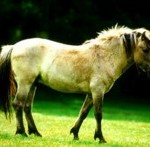 AMSTERDAM - The Netherlands is donating more than two dozen horses and cattle, close relatives of now extinct species, to Latvia to help the Baltic country preserve its open lands, conservationists said on Wednesday.
AMSTERDAM - The Netherlands is donating more than two dozen horses and cattle, close relatives of now extinct species, to Latvia to help the Baltic country preserve its open lands, conservationists said on Wednesday. The 23 Konik horses and 2 wild cows will be introduced later this month in Latvia's Kemeri National Park, where plant and animal species are threatened because abandoned land is turning into closed forest, the Dutch-based conservation organisation the Large Herbivore Foundation (LHF) said.
The grazing and roaming of the animals, donated by the Dutch state forestry service, will help maintain open vegetation and country, important for the survival of other species, the group said.
"After the breakdown of the Soviet Union and the restored independence of the Baltic countries, huge areas of agricultural land were abandoned," an LHF statement said.
"The abandoned land is slowly overgrown by thickets and trees, gradually leading to a closed forest. In this process plant and animal species depending on open vegetations and the open country disappear."
Konik horses are a primitive breed close to the now extinct European wild horse, the Tarpan. It inhabited Eastern Europe until the 19th century when Polish farmers captured the last Tarpan horses and crossed them with their own workhorses.
The result was a strong, hard working and manageable horse, which they named the Konik.
The cattle are a relative of the Aurox, the big grazing ancestor of today's domestic cattle. These wild cattle lived along rivers and half-open forests with their habitat stretching over the Eurasian and North African continents.
The Aurox became extinct around 1627, scientists say. In 2003 and 2004, the LHF with the help of other conservation groups took Bisons, wild cows and Konik horses to another Latvian nature park.
The LHF is involved in 30 projects in Europe, Russia, Mongolia and Central Asia, aiming to protect some 45 species and restore their ecological role within their original habitat.
The Netherlands is one of the world's main breeding centres for wild horses and cattle.



